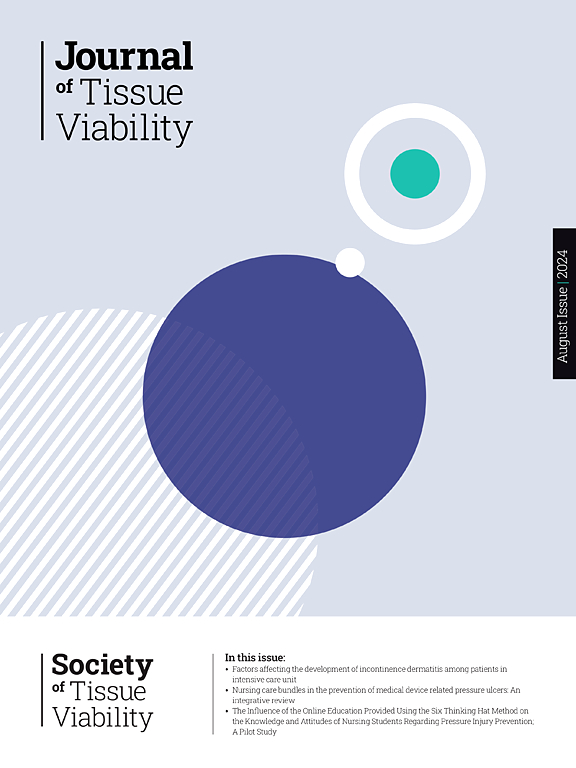硅酮粘合多层泡沫敷料可预防医院获得性骶骨压疮:基于公共资助的实用随机对照试验与真实世界数据的经济评估。
IF 2.4
3区 医学
Q2 DERMATOLOGY
引用次数: 0
摘要
目的估算骶骨多层硅酮泡沫敷料作为辅助预防疗法与标准压疮预防疗法相比,在医院压疮高危人群中的成本效益。方法从医疗支付方的角度进行经济评估。该评估以比利时一项由政府资助的实用随机对照试验(RCT)为基础,并与行政索赔数据库中的实际数据和比利时成本分析相结合。结果随机对照试验表明,在治疗组中,骶骨发生新褥疮的风险在统计学上显著降低了 41%(RR = 0.59,95 % CI 0.35-0.98,p = 0.04)。绝对风险降低了 2.0 % (95 % CI -0.1-4.1 %),这与预防一个新的 II 类或更严重压疮所需的治疗次数 50.0 相吻合。第 3 天前出现压疮的患者的生活质量平均为负值,而未出现压疮的患者的生活质量则为正值。在保守假设的情况下,即不包括多层硅酮泡沫敷料的价格折扣,也不包括住院期间的费用,使用骶骨敷料预防压疮已经不增加成本。本文章由计算机程序翻译,如有差异,请以英文原文为准。
Silicone adhesive multilayer foam dressings to prevent hospital-acquired sacrum pressure ulcers: An economic evaluation based on a publicly funded pragmatic randomized controlled trial linked with real-world data.
OBJECTIVES
To estimate the cost-effectiveness of sacrum multilayer silicone foam dressings as an adjuvant prophylactic therapy compared to standard pressure ulcer prevention in a hospital population at high risk for pressure ulcer development.
METHODS
An economic evaluation is performed from a healthcare payer's perspective. This evaluation is based on a Belgian publicly funded pragmatic randomized controlled trial (RCT), linked with real-world data from administrative claims database and a Belgian cost analysis. A cost-consequences analysis with a one-year time horizon is performed.
RESULTS
The RCT has shown that the risk of developing a new pressure ulcer on the sacrum was statistically significantly reduced by 41 % in the treatment group (RR = 0.59, 95 % CI 0.35-0.98, p = 0.04). The absolute risk reduction of 2.0 % (95 % CI -0.1-4.1 %) coincides with a number needed to treat of 50.0 to prevent one new pressure ulcer of category II or worse. The evolution of quality of life is on average negative for patients who developed a pressure ulcer before day 3, while it is positive for patients without pressure ulcers. In a scenario with conservative assumptions, i.e. without inclusion of price discounts for the multilayer silicone foam dressings and only including costs during the hospitalization, pressure ulcer prevention with dressings on the sacrum was already cost-neutral.
CONCLUSIONS
The preventive use of silicone adhesive multilayer foam dressings on the sacrum for a population similar to the pragmatic trial population can be supported both from a clinical and economic point of view.
求助全文
通过发布文献求助,成功后即可免费获取论文全文。
去求助
来源期刊

Journal of tissue viability
DERMATOLOGY-NURSING
CiteScore
3.80
自引率
16.00%
发文量
110
审稿时长
>12 weeks
期刊介绍:
The Journal of Tissue Viability is the official publication of the Tissue Viability Society and is a quarterly journal concerned with all aspects of the occurrence and treatment of wounds, ulcers and pressure sores including patient care, pain, nutrition, wound healing, research, prevention, mobility, social problems and management.
The Journal particularly encourages papers covering skin and skin wounds but will consider articles that discuss injury in any tissue. Articles that stress the multi-professional nature of tissue viability are especially welcome. We seek to encourage new authors as well as well-established contributors to the field - one aim of the journal is to enable all participants in tissue viability to share information with colleagues.
 求助内容:
求助内容: 应助结果提醒方式:
应助结果提醒方式:


